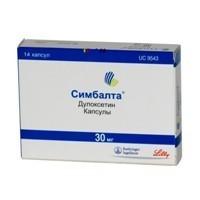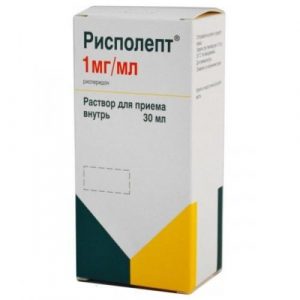Description
Release form
Capsules
Packing
14 pcs.
Pharmacological action
Symbalta has an antidepressant effect. Duloxetine is an antidepressant, serotonin and norepinephrine reuptake inhibitor, and weakly inhibits dopamine uptake, without significant affinity for histaminergic, dopaminergic, cholinergic and adrenergic receptors. The mechanism of action of duloxetine in the treatment of depression is to suppress the reuptake of serotonin and norepinephrine, resulting in increased serotonergic and noradrenergic neurotransmission in the central nervous system. Duloxetine has a central mechanism for suppressing pain, which, in the first place, is manifested by an increase in the threshold of pain sensitivity for pain syndrome of neuropathic etiology.
Indications
Depression.
A painful form of diabetic neuropathy.
Contraindications
Hypersensitivity to the drug.
Concomitant use with monoamine oxidase inhibitors (MAOIs).
Uncompensated angle-closure glaucoma
Caution
For exacerbation of manic / hypomanic state, epileptic seizures, mydriasis, impaired liver or kidney function, with the likelihood of suicidal attempts.
Use during pregnancy and lactation
Due to insufficient experience with the use of Simbalta during pregnancy, the drug should be prescribed during pregnancy only if if the potential benefit to the patient significantly exceeds the potential risk to the fetus. Patients should be warned that in the event of pregnancy or its planning during treatment with duloxetine, they need to inform their doctor.
Due to the lack of experience in the use of duloxetine in women during breastfeeding, breastfeeding during therapy with duloxetine is not recommended.
Special instructions
Monoamine oxidase inhibitors (MAOIs). In patients receiving a serotonin reuptake inhibitor in combination with MAOI, there were cases of serious reactions, sometimes with a fatal outcome, among which there were hyperthermia, rigidity, myoclonus, peripheral disorders with possible sharp fluctuations in indicators of vital functions and changes in mental status, including severe agitation with the transition to delirium and to whom. These reactions were also observed in patients who, shortly before the administration of MAOI, a serotonin reuptake inhibitor was canceled. In some cases, patients had symptoms characteristic of a neuroleptic malignant syndrome. The effects of the combined use of duloxetine and MAOI have not been evaluated in humans or animals. Therefore, given the fact that duloxetine is an inhibitor of both serotonin and norepinephrine, it is not recommended to take duloxetine in combination with MAOI or for at least 14 days after discontinuation of MAOI treatment. Based on the half-life of duloxetine, a break should be made, at least 5 days after the end of taking duloxetine before taking the MAOI.
Exacerbation of manic / hypomanic state: as with the use of similar drugs that affect the central nervous system, duloxetine should be used with caution in patients with a history of manic episodes.
Epileptic seizures: as with similar drugs that affect the central nervous system, duloxetine should be used with caution in patients with a history of epileptic seizures.
Mydriasis: there have been cases of mydriasis when taking duloxetine, therefore caution should be exercised when prescribing duloxetine to patients with increased intraocular pressure or in individuals at risk of developing acute angle-closure glaucoma.
Impaired liver or kidney function: in patients with severe renal impairment (creatinine clearance <30 ml / min) or severe liver failure, an increase in plasma concentration of duloxetine is observed. If duloxetine is clinically justified in such patients, lower initial doses should be used. Suicidal Attempts: For depression, there is a chance of suicidal attempts that can persist until persistent remission occurs. Careful monitoring of patients at risk is necessary. Composition 1 caps. contains duloxetine (as hydrochloride) 30 mg Dosage and administration of Simbalt is administered orally, regardless of food intake. Capsules should be swallowed whole without chewing or crushing. Do not add Simbalta to food or mix with liquids, as this can damage the enteric capsule. The recommended starting dose for Symbalta is 60 mg once daily. If necessary, it is possible to increase the dose to a maximum dose of 120 mg per day in 2 divided doses. A systematic assessment of taking Simbalta at a dose of over 120 mg has not been conducted. In the terminal stage of chronic renal failure (CC less than 30 ml / min), the initial dose of Symbalta is 30 mg once a day. Side effects Most common (10%): dizziness (except vertigo), dry mouth, nausea, constipation, sleep disturbances (drowsiness or insomnia), headache (less often, than with placebo). Less often (1-10%): diarrhea, vomiting, tremor, decreased appetite, weight loss, weakness, increased sweating, hot flashes, blurred vision, anorgasmia, decreased libido, delayed and impaired ejaculation, and erectile dysfunction. A slight increase in fasting blood glucose in patients with a painful form of diabetic neuropathy. Dizziness, nausea, headache were noted as frequent adverse effects during the withdrawal of duloxetine. Drug Interactions Drugs Metabolized by CYP1A2. The simultaneous use of duloxetine (60 mg 2 times a day) did not significantly affect the pharmacokinetics of theophylline metabolized by CYP1A2. Duloxetine is unlikely to have a clinically significant effect on the metabolism of CYP1A2 substrates. Inhibitors of CYP1A2. Because, Since CYP1A2 is involved in the metabolism of duloxetine, simultaneous administration of duloxetine with potential CYP1A2 inhibitors is likely to lead to an increase in the concentration of duloxetine. A potent CYP1A2 inhibitor fluvoxamine (100 mg once daily) reduced the average plasma clearance of duloxetine by approximately 77%. Caution should be exercised when prescribing duloxetine with CYP1A2 inhibitors (for example, some quinolone antibiotics) and lower doses of duloxetine should be used. Drugs metabolized by CYP2D6. Duloxetine is a mild inhibitor of CYP2D6. When taking duloxetine at a dose of 60 mg 2 times a day, along with a single dose of desipramine, substrate CYP2D6, AUC of desipramine increases 3 times. The simultaneous administration of duloxetine (40 mg 2 times a day) increased the stable part of the AUC of tolterodine (2 mg 2 times a day) by 71%, but had no effect on the pharmacokinetics of the 5-hydroxyl metabolite. Therefore, caution should be exercised when using duloxetine with drugs that are mainly metabolized by the CYP2D6 system and have a narrow therapeutic index. Inhibitors of CYP2D6. Since CYP2D6 is involved in the metabolism of duloxetine, the simultaneous use of duloxetine with potential CYP2D6 inhibitors can lead to increased concentrations of duloxetine. Paroxetine (20 mg once daily) reduced the average clearance of duloxetine by approximately 37%. Caution should be exercised when using duloxetine with CYP2D6 inhibitors (e.g., SSRIs). Drugs affecting the central nervous system. Caution should be exercised when using duloxetine together with other drugs and agents that affect the central nervous system, especially those that have a similar mechanism of action, including alcohol. Drugs highly binding to blood proteins. Duloxetine is significantly bound to plasma proteins (> 90%). Therefore, the administration of duloxetine to a patient who is taking another drug that binds to plasma proteins to a high degree can lead to an increase in the concentration of free fractions of both drugs.
Overdose
Several cases of overdose have been reported with single-dose ingestion up to 1400 mg of the drug with no fatal effects. Overdose can be accompanied by the following symptoms: tremor, clonic convulsions, ataxia, vomiting and decreased appetite.
Overdose treatment. The specific antidote is unknown. It is recommended to monitor the cardiac activity and monitor the main indicators of vital activity, along with the conduct of symptomatic and supportive treatment.
Storage Conditions
At 15-30 ° C, out of the reach of children.
Shelf life
3 years.
Terms and conditions otpuska from
pharmacies Prescription
dosage form
capsules
Possible product names
SYMBALTA 0.03 N14 CAPS
Simbalta 30mg Caps. enteric-soluble X14
SYMBALTA CAPS 30 MG BLIST No. 14
Simbalta caps 30mg x 14
SIMBALTA CAPS. 30MG N14




